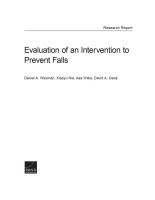| 来源类型 | Research Reports
|
| 规范类型 | 报告
|
| DOI | https://doi.org/10.7249/RR1649
|
| ISBN | 9780833096623
|
| 来源ID | RR-1649-ASPEC
|
| Evaluation of an Intervention to Prevent Falls |
| Daniel A. Waxman; Xiaoyu Nie; Asa Wilks; David A. Ganz
|
| 发表日期 | 2016
|
| 出版年 | 2016
|
| 页码 | 66
|
| 语种 | 英语
|
| 结论 |
The Intervention Did Not Substantially Affect Costs- No statistically significant effect on costs was detected.
- The 95-percent confidence interval for the intervention's effect on total monthly Medicare costs ranged from a $94-per-month decrease to a $130-per-month increase.
- The 95-percent confidence interval for the intervention's effect on direct injury–related Medicare costs ranged from a $12-per-month decrease to a $48-per-month increase.
Researchers Did Not Detect an Effect on the Frequency of ED Visits for Fall-Related Injuries- No statistically significant effect on fall-related ED visits was detected.
- The 95-percent confidence interval for the estimated effect of the intervention on the incidence of fall-related injuries leading to ED visits ranged from a 26-percent reduction to a 43-percent increase (i.e., an incidence rate ratio of 0.74 to 1.43). The wide range of this estimate suggests that the study was underpowered for this outcome and that a clinically meaningful effect could have gone undetected.
Researchers Developed and Validated a Model That Can Be Used to Measure the Incidence of Fall-Related ED Visits Without Relying on External Cause-of-Injury Codes- The model assigns each ED visit a probability weight that represents the likelihood that the visit was precipitated by a fall.
- The weights can be summed to measure the incidence of fall in a given population and time interval. They can also be used to determine the incidence of particular fall-related injuries of interest by summing the weights for ED visits during which particular injuries were diagnosed.
|
| 摘要 |
- For future evaluations of interventions aimed at preventing fall-related injuries, study outcomes derived from Medicare claims offer several advantages over self-reported data. Their primary disadvantage is that, at present, claims are available only for beneficiaries enrolled in fee-for-service Medicare. Advantages of claims-based outcomes include that they are not subject to recall bias, they allow for measurement of baseline differences in costs or the incidence of fall-related injuries, and they allow for intention-to-treat analyses. Because claims-based outcomes can be measured without costly follow-up calls, such outcomes might facilitate larger-scale studies of population-based interventions.
- When the goal is to use health care claims as a surrogate for measuring whether or not a fall-related injury occurred, either direct injury-related costs or the estimated rate of falls might be better measures than total costs.
- Cost-effectiveness analyses that consider not only health care costs but also improvements in health could be an important step in understanding the value of these interventions.
|
| 主题 | The Elderly
; Geriatrics
; Health Care Program Evaluation
; Medicare
; Preventive Health Care
|
| URL | https://www.rand.org/pubs/research_reports/RR1649.html
|
| 来源智库 | RAND Corporation (United States)
|
| 引用统计 |
|
| 资源类型 | 智库出版物
|
| 条目标识符 | http://119.78.100.153/handle/2XGU8XDN/108361
|
推荐引用方式
GB/T 7714 |
Daniel A. Waxman,Xiaoyu Nie,Asa Wilks,et al. Evaluation of an Intervention to Prevent Falls. 2016.
|
|
文件名:
|
x1495316349047.jpg
|
|
格式:
|
JPEG
|

|
文件名:
|
RAND_RR1649.pdf
|
|
格式:
|
Adobe PDF
|
除非特别说明,本系统中所有内容都受版权保护,并保留所有权利。